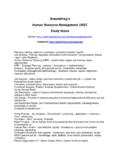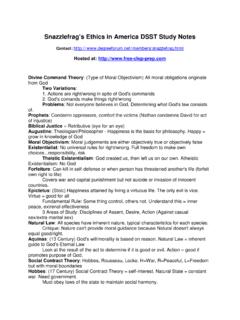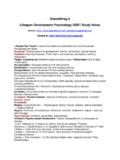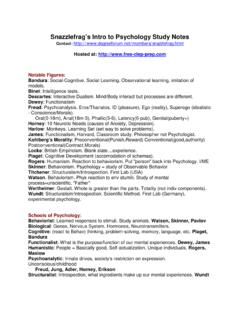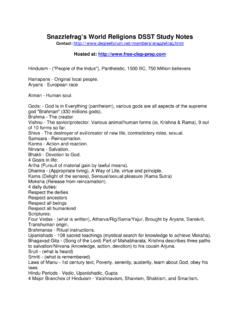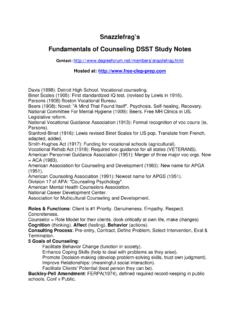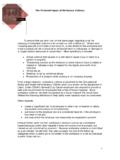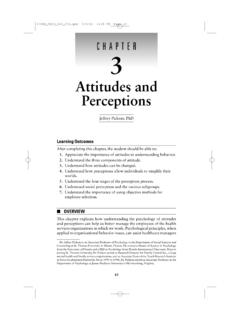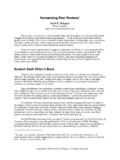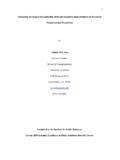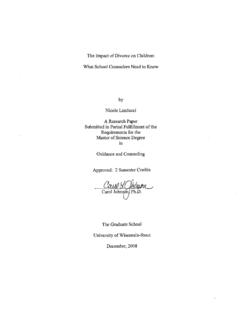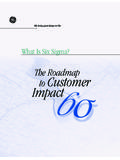Transcription of Snazzlefrag’s Organizational Behavior DSST Study …
1 snazzlefrag sOrganizationalBehavior DSSTS tudy NotesContact: at: : How people behave in organizations, application of this Elements: People, structure, technology, environmentHuman Nature: Each indiv 1) Unique 2) Total human 3) Guided by motivations 4) : 1)Social systems/govnd by social laws & indiv needs. 2)Have > Group-> : Industrial Revolution. 1800s=some training/improved (Principles of Scientific Management 1911): Father of Scientific factors influence technical : Org=Social System AND workers are most important. Mayo/Roethlisberger(Hawthorne).1948-1952 : Formal Study of OB began to Douglas McGregor: Management=Theory X (autocratic), Theory Y (humanistic)Modern Organizational Theory: Organizations are systems of interrelated of OB:Scientific Method: Observe, Explain, Predict/Hypothesis, Test Hyp, Draw Variable: The Effect-to be explained/predicted (affected by theindependent variable)In OB: Productivity (effectiv/effic), Absenteeism, Turnover, Job Satisfaction(expected/actual rewards).
2 Independent Variable: The Cause-changes in IV affects the : Age, gender, marital : Job Satisfaction can affect Absenteeism Designs: Observation, Survey, Field Study , Case Study , Field Exp,Laboratory ExpManagement Functions-Planning, Organizing, Staffing, Directing, Skills-(Katz) Technical (expertise), Interpersonal (human), Conceptual(probsolv).Managerial Roles-(Mintzberg) Informational, Interpersonal, , Disseminator, , Liaison, , Disturbance-handler, Resource-allocator, Relations-(Mayo & Roethlisberger) Hawthorne (Weber)Systems-(Chester Barnard) Inputs/transformations/outputs, everything affectseverything (Drucker) Management by Objectives (MBO).
3 Approaches: Trait, Behavioral, ContingencyContingency-Best approach that fits the & Schmidt: Boss-centered and Subordinate-centered : High LPC (relationships), Low LPC (task-oriented/Extremes).. : Path-Goal Theory-Supportive and Directive LeadershipScientific-(Gilbreth,Taylor,Ga ntt) (oldest approach) Most efficient way to do a job(Focus on BOTTOM).Studying, Selecting,Training, (Fayol) (Focusses on the TOP).Behavioral/Human Relations-(Mayo & Roethlisberger) Hawthorne & (Weber)Humanistic-Rogers. workers are driven by the need to realize their own (Chester Barnard) Inputs/transformations/outputs, everything affectseverything (Drucker) Management by Objectives (MBO).
4 Barnard-SYSTEMS (open system)Gilbreth-SCIENTIFIC, "One Best Way", Science of , "Father of Scientific Management".Gantt-SCIENTIFIC, Gantt Charts (scheduling).Fayol-CLASSICAL/ADMINISTRAT IVE, "Father of Modern Management". 1st definedfunctions of & Roethlisberger-BEHAVIORAL/HUMAN RELATIONS, Hawthorne Likert-System 4 (Participative)Drucker-PARTICIPATIVE, 8 Key Results Areas, MBO8 Key Results Market Share 2. Productivity (Output divided byInput)3. Profitability4. Innovation 5. Resources6. Worker Performance7. Manager Performance 8. SocialResponsibilityPerformance Appraisal-Ranking, MBO, Graphic Rating Scales (traits).Human Asset Accounting-Appraisal of overal company morale Process & Characteristics:Perception: Select/Organize(categorize)/Interpret Stimuli.
5 Then behave Attention: Selecting what we will attend to out of 1000s of competing stimuli."speed read"Perceptual Organization: (infl by personal experience) Organizing/categorizing Perception: Perceiving other by: Person being Perceived,Situation, PerceiverBarriers: Stereotyping, Halo Effect, Implicit bias, Contrast(context), SelectivePerception, Projection(self).Influences:Attitudes, motives, interests, past experience (new experiences),expectations, situationAttributional Approaches(perception/beh): Behavior is influenced byenvironment/personal as to cause influenced by: Distinctiveness, Consensus, , Late for work : Boss perceives laziness(internal), Boss perceives traffic accident(external)Fundamental Error: Underestimate external factors for others, overestimate internalfactors for success = hard work , their success = late = car broke, their late = Locus of Control(Rotter): We can influenceoutcome of Locus of Control(Rotter): Outcomes are imposed by others (out of ourcontrol).
6 Self-fulfilling Prophecy(Pygmalion Effect): Meeting the Low or High Expectations : Psychoanalytic, Trait, Humanistic, : Characteristic way of thinking, feeling, behaving. Ability to adjust , Environment, SituationType A: Competetive, Urgency, Achievement, Ambitious, Obtaining MaterialWealth("stuff").Personality-Job Fit(Holland): Vocational Pref Inventory (1600q)Social, Conventional(accnt), Realistic(physical), Investigative, Enterprising(lwyr,power),ArtisticPsychoa nalytic: Personality = conflict b/n pleasure-seeking impulses(id) and socialrestraint(ego).Trait(biological): Self-esteem, Self-monitoringEmot Stab <-> Emot Instab, Extro <-> Intro, Open <-> Rigid, Agree <-> Disagree,Conscientious <-> : (MBTI) 100q, 16 pers types.
7 Extro/Intro,Sensing/Intuit,think/feel,pe rciev/judge3-factor (Eysenck) Extrov/introv, Neurotic/Stable, (Norman) Extrov,Neurotic(emotstab),Openness,Agree ableness, (outside forces-less job sat, more absentee,alienated)Internals(controlown destiny)Machiavellianism(High Mach): Pragmatic, Emotional Distance, Ends Justify Means (atall costs)Flourish in face-to-face interactions, and when minimal :Maslow: Hierarchy, : Self-concept (agent/I,object/me)Social-cognitive: Personality influenced by interrelationship b/n people and of : Change in ACTIONS/ Behavior (not just thought/attitudes) via Conditioning(Pavlov): Learn an unusual response to a stimulus.
8 (Dogs: Bell= Food/Salivate)Operant Conditioning(Skinner): "Consequences". Desired Behavior = reward, orprevents (positive reinf) = Behavior increases. Remove reward (negative reinf) = Behavior : Observation/Direct Experience (Eg, observe reward or punishment asin OpCond)Shaping: Gradually Increase pos/neg reinforcement. 30min late, 20min late, 10min late,on : Observe own Behavior , compare to others, reward self if Reinforcement Schedule: Every time a Behavior is Reinforcement Schedule: "Slot machine". Just enough to encouragecontinued Reinforcement Schedule: Uniform time intervals (ie, payday).Variable-interval Reinforcement Schedule: "Pop quizzes", "UnannouncedInspections"Fixed-ratio Reinforcement Schedule: "Piece work ".
9 More work = more Reinforcement Schedule: "Sales Commission"-Number of calls toclose a sale : Evaluative Components: Cognition, Effect, Behavior (beliefs/feelings/intentions)Inf luenced by: Stimuli in the Environment-Family,Peer Groups, Society, Formation: Cultural Influences, Group Membership, Family, Prior Satisfaction: I like my job (expect).Job Involvement: Identifying with, caringabout, valuing the work you Dissonance: (Festinger-Cult Study ) Discomfort w/ discrepancy b/n whatyou knew, and new Theory: Attitudes formed after the fact. "I had this job for 10yrs, so Imust like it".Escalation of Commitment: Increase commitment to a wrongdecision.
10 "good moneyafter bad". Can't admit : What ought and what ought not to Whether How important?Value Hierarchy: Rank values in intensity(importance). Freedom, pleasure,self-respect, honesty, obedience, 's 6 Types of Values: Theoretical, economic, aesthetic, social, political, Value Survey: 2 sets of values (18 items each). Terminal (lifetime goals) (how to achieve).Motivation: Effort, Organizational Goals, Individual needs. [Process Theories andContent Theories]Rogers: (Humanistic) People are driven by the need to realize their own 's Hierarchy of Needs: Lower/Ext<---Physiological, Safety | Social, Esteem,Self-actualization--->Higher/IntMcGregor-Theory X, Theory Y.
